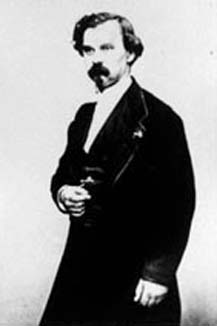Jules Antoine Lissajous
Jules Antoine Lissajous (born March 4, 1822 in Versailles , † June 24, 1880 in Plombières-lès-Dijon ) was a French physicist .
Lissajous became known for the Lissajous figures named after him , which arise when linear vibrations are superimposed . Their shape depends on the frequency ratio and the phase angle difference present at the beginning . In the case of unequal frequencies, an unchangeable figure results if both frequencies form a rational relationship. Otherwise the trajectories will not repeat themselves, the Lissajous figure will change constantly. At the same frequencies, ellipses of different eccentricity result .
In 1855, Lissajous described a method for representing such vibrations. In 1873 he was awarded the Lacaze Prize by the Académie des Sciences for his work on the observation, measurement and interpretation of vibrations. A simple experimental arrangement to imitate Lissajou's work could look like this: A pendulum is suspended in such a way that the pendulum can move not only in one plane but in different directions. It is first caused to vibrate by a shock. Then the pendulum receives another push in another direction. The pendulum now oscillates in two different directions at the same time, with the result that the path of the pendulum mass describes a very complicated but closed line, namely a Lissajous curve. You can record it by using a funnel filled with sand as a vibrating mass, from which the sand slowly flows out. Such a device for recording Lissajous figures is called a harmonograph .
Nathaniel Bowditch wrote the first description of such figures in 1815 in connection with an attempt to simulate the apparent movements of the moon.
In 1879 he became a corresponding member of the Académie des Sciences. In space travel, the Lissajous orbit is named after Lissajous.
Fonts
- Sur la position des noeuds dans les lames qui vibrent transversalement, 1850
- Sur un cas particulier de stéréoscopie fourni par l'étude optique des mouvements vibratoires, 1856
- Mémoire sur l'étude optique des mouvements vibratoires, Paris: Mallet-Bachelier 1857
- And in: Annales de chimie et de physique. Ser. 3, vol. 51, 1857, p. 147, Gallica
Web links
- John J. O'Connor, Edmund F. Robertson : Jules Antoine Lissajous. In: MacTutor History of Mathematics archive .
Individual evidence
- ^ List of members since 1666: Letter L. Académie des sciences, accessed on January 14, 2020 (French).
| personal data | |
|---|---|
| SURNAME | Lissajous, Jules Antoine |
| BRIEF DESCRIPTION | French physicist, developer of the Lissajous figures |
| DATE OF BIRTH | March 4, 1822 |
| PLACE OF BIRTH | Versailles |
| DATE OF DEATH | June 24, 1880 |
| Place of death | Plombières-lès-Dijon |
